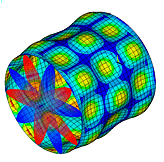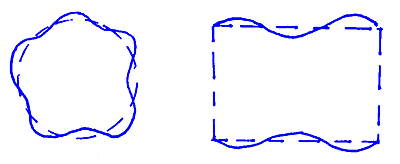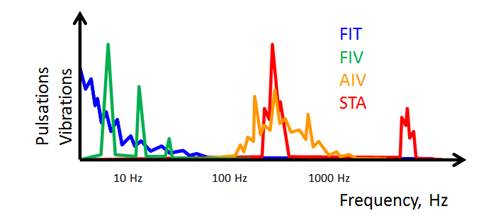Services
- Static Equipment & Structures (Piping Vibration & Fatigue)
- Acoustic Fatigue Assessment for Blowdown Systems
- Acoustic-Induced Vibration (AIV) Analysis
- Finite Element Analysis (FEA) and Computational Fluid Dynamics (CFD)
- Flow-Induced Turbulence (FIT) Analysis
- Flow-Induced Vibration (FIV) Analysis
- Multiphase and Slug Flow Analysis
- Pipe Stress Analysis
- Piping Vibration and Integrity Assessment
- Review & Design Support Services
- Small-Bore Connections (SBC) Assessment
- Structural Vibration and Dynamic Design Analysis
- Subsea Piping Vibration
- Thermal Striping
- Tube Failure Analysis
- Veridian AM
- Veridian VS
- Vibration Inspection Program
- Water Hammer Analysis
- Machinery Analysis
- Bottle Sizing Service
- Compressor Package Engineering
- Finite Element Analysis (FEA) and Computational Fluid Dynamics (CFD)
- Foundation Design and Dynamic Analysis
- Fuel Gas Compressor Piping Transient Analysis
- Lateral Vibration Analysis
- Pipe Stress Analysis
- Pulsation & Mechanical Analysis: Reciprocating Compressor
- Pulsation & Mechanical Analysis: Reciprocating Pump
- Pulsation & Mechanical Analysis: Screw Compressor
- Pump RCF Analysis
- Review & Design Support Services
- Shell Transverse Acoustical (STA) Analysis
- Skid Design and Analysis
- Surge Control Design for Centrifugal Compressor Systems
- Torsional Vibration Analysis (TVA)
- Field Engineering & Troubleshooting
- Finite Element Analysis (FEA) and Computational Fluid Dynamics (CFD)
- Human Vibration
- Motion Amplification Vibration Analysis
- Noise Troubleshooting
- Performance Assessment (Thermodynamic)
- PostPro – field data processing and analysis
- Structural Vibration Troubleshooting
- Thermal Striping
- Troubleshooting, Root Cause Analysis (RCA)
- Veridian iDAC
- Vibration Inspection Program
Shell Transverse Acoustical (STA) Analysis
Vibration/Noise on Vessels and Piping Walls

Centrifugal and screw compressors generate pulsations at vane passing frequency (VPF). These pulsations can excite transverse acoustical modes of the gas and can also excite shell modes of thin-walled pipe and vessels. When these shell modes and transverse acoustical modes match the compressor VPF, severe shell wall vibration will occur. This vibration can cause fatigue failure of nearby small-bore connections and generate excessive noise problems.
Wood provides design and field services to identify and resolve shell mode vibration problems.
1 Background
Transverse acoustical waves travel perpendicular to the direction of flow and radiate outwards to the piping (shell) wall. If the shell mode natural frequency matches the transverse acoustical frequency, the wall will become resonant and amplify the vibration.
Thin-walled piping and vessels have many shell modes of vibration. The figure below shows a section of pipe with five (5) circumferential nodes and three (3) axial nodes. The figure also shows a cross-section of the pipe, with a representation of an acoustic mode of high and low pressure. If this acoustic mode matches the shell mode, there is the potential for high vibration. The excitation force that creates the high shell vibration is a result of the pressure pulsations generated by the compressor at VPF. If these frequencies line up – VPF, shell modes of the pipe, and acoustic modes of the gas – then the result is high pipe or vessel vibrations.
 |
 |
| Acoustic mode of high and low pressure | Five Circumferential Nodes Three Axial Nodes |
As shown in the following chart, shell transverse acoustical (STA) vibration occurs at medium to high frequencies and can generate high amplitudes. Evaluating and mitigating STA for an existing facility (field service) or during the construction phase (design service) is an advanced study within Wood’s Piping Vibration and Integrity Assessment
 |
-FIT (Flow-Induced Turbulence) -FIV (Flow-Induced Vibration) -AIV (Acoustic-Induced Vibration) -STA (Shell Transverse Acoustical) |
| Excitation sources studied in Wood's Piping Vibration Assessment | |
2 Related Information
3 Related Services
- Piping Vibration and Integrity Assessment
- Flow-Induced Vibration Analysis
- Flow-Induced Turbulence Analysis
- Acoustical Induced Vibration Analysis
- Small-Bore Connections (SBC) Assessment
- Troubleshooting, Root Cause Analysis (RCA)
4 Key Words
- Fluid structure interaction
- Transverse modes
- Shell modes
More Info
Webinar: Shake, rattle and grow (2022 update) • Webinar: Controlling dynamic flexibility • Webinar: Piping and tubing vibration anomaly mgmt • Multi-channel vibration measurements • Vibration-induced fatigue management (Offshore Magazine) • Webinar: Shake, rattle and grow I (2022 update) • Avoiding vibration-induced fatigue failure • Examples of Piping Vibration (Video) • Pipe Support Stiffness, GMRC Project • Transient Conditions on Small-Bore Piping • Piping Vibration Design Considerations • Tips for Managing a Successful Vibration Project • Piping Vibration Examples • An Integrated Approach to Manage Vibration Risks •
Free webinar
Learn how to select and design vibration control solutions that work – using real-world data and case studies. Register now



